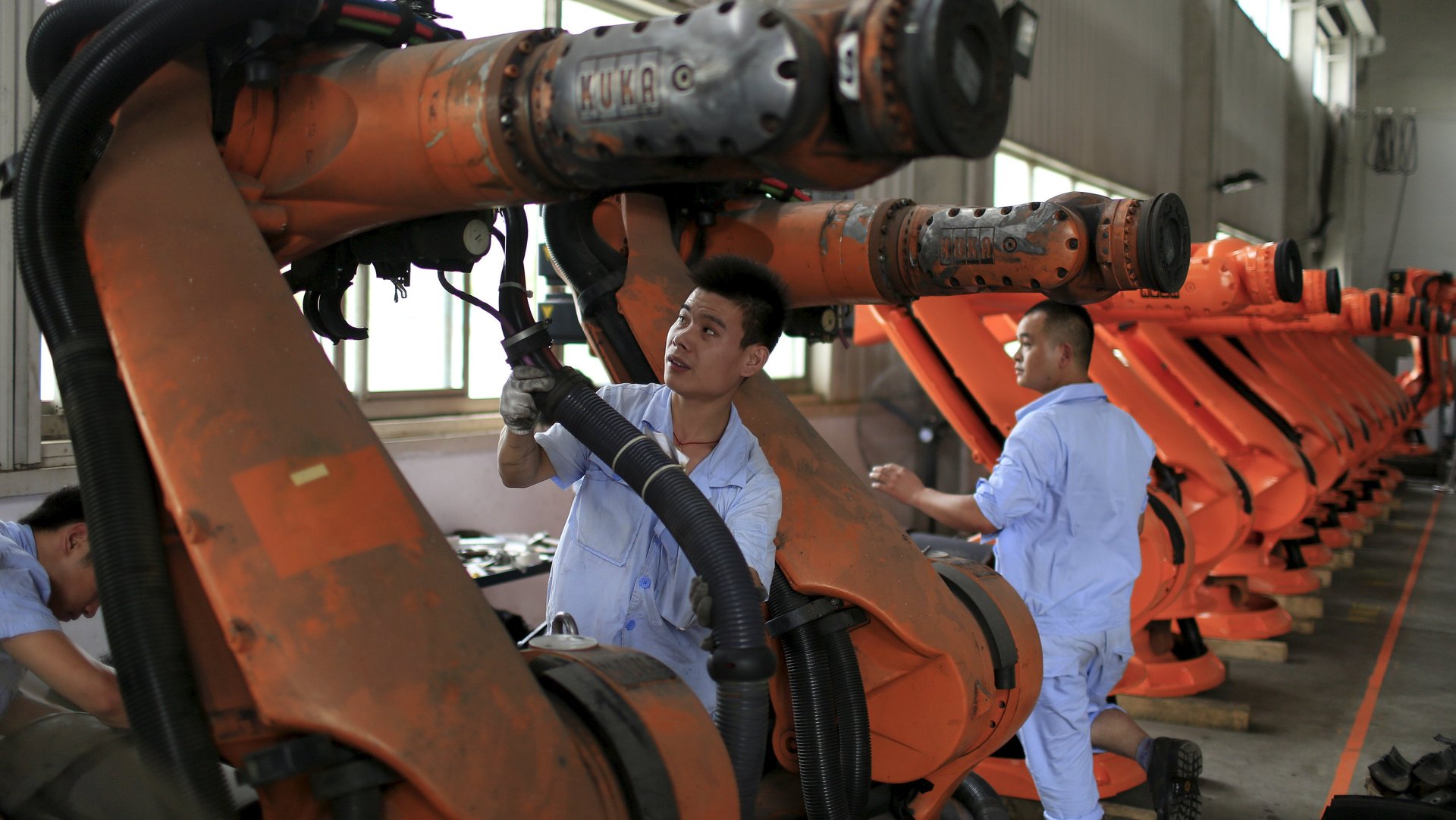The US can’t beat China’s robots—but it can win by building the machines that make them
As a US presidential candidate, Donald Trump made keeping manufacturing jobs in the country a key economic issue. He promised to bring back jobs from China, Mexico, Japan, and elsewhere; he pledged to force companies from Ford to Apple to Nabisco to open or re-open factories on American shores; and he vowed to revive the coal and steelmaking industries. His promise to create industrial jobs was key to his electoral victory.


As a US presidential candidate, Donald Trump made keeping manufacturing jobs in the country a key economic issue. He promised to bring back jobs from China, Mexico, Japan, and elsewhere; he pledged to force companies from Ford to Apple to Nabisco to open or re-open factories on American shores; and he vowed to revive the coal and steelmaking industries. His promise to create industrial jobs was key to his electoral victory.
Still, many were—and remain—deeply skeptical of Trump’s plans. Mark Cuban, internet entrepreneur and frequent thorn in the side of the president, says that bringing back manufacturing will backfire and lead to overall job losses. Instead, he says, the US ought to invest in robotics to compete with China. “We have to win the robotics race,” he says. “We are not even close right now.” (For what it’s worth, Trump’s labor secretary Steven Mnuchin recently disagreed, saying robots aren’t even “on my radar screen.”)
Cuban is on the right track, but the fact is that it’s too late to go head-to-head with China on building robots alone. We can’t compete with China’s robot revolution. But we can complement it.
The US should focus on what it does best: software, sensors, and design. Building the factories and production lines of the future demands the kind of expertise that US-based engineers and system integrators are best positioned to deliver. After all, we built the internet. So let’s build the Internet of Things, starting in the factory.
This starts with accepting that industrial robots—which include everything from the huge, robotic arms used in automotive assembly lines to the tiny, nimble machines that pharmaceutical plants use to package pills—are not likely to be manufactured at scale in the US any time soon. Or maybe ever. Over the past 25 years, the Chinese government has invested billions in this industry. According to the International Federation of Robotics, China now captures 27% of the market and is by far the largest—and fastest growing—producer and consumer of industrial robots.
But the US doesn’t need to build industrial robots. There’s less money in hardware, and besides: It’s not our forte. Instead, we need to channel our resources into what Elon Musk calls “building the machine that builds the machine.”
There’s a lot of room for innovation. Today’s production lines are notoriously inflexible. Manufacturing stoppages, delays, and disruptions—whether they’re caused by equipment failure, human error, or a combination of the two—are a billion-dollar headache for manufacturers. Not only do stoppages reduce production volume, they also represent an opportunity cost, because downtime could have instead gone toward making products and generating profit. Meanwhile for employees, line disruptions are often associated with accusations about work quality, disputes with management, and even lost wages.
It doesn’t have to be this way. The US has an opportunity to create production lines that are flexibly programmable, information-rich, and dynamically reconfigurable. By developing new sensors and software that make lines run more efficiently, companies will be able to cut costs and deliver goods at a pace approximating the speed of the market. By writing the code and performing the skilled labor that stitches independent robots together, companies and organizations will reap the benefits of an interdependent, productive system that allows robots to interact intelligently with human workers. And workers benefit, too. New feedback and control options will allow them to tailor their work to suit their abilities and preferences, which will reduce the potential for injuries and errors, and make their work more fulfilling.
If you live in America, this means manufacturing could come home, bringing jobs with it. The best factories will also be the cheapest to operate, but their inner workings will become as much of a trade secret as microchip designs are now. This will likely mean they will be located in countries that have strong IP protection, can supply the labor required to design and build them, and that have a large consumer base nearby. The US meets all those criteria in spades.
If we focus on these kinds of efforts, we can secure our advantage for a generation. And Trump could help. His administration could make the robotics race a signature component of its economic and scientific agenda—the modern day equivalent of the Apollo Mission. Trump has enormous power to get manufacturers and technology executives onboard. He could, for instance, offer tax breaks and other financial incentives to companies investing in key capabilities. He could also fund programs that train workers and give them the skills they need to compete.
The US has an opportunity to lead the world, capitalize on its strengths, and unleash massive value in this industrial renaissance. Trying to beat the Chinese at their own game—let alone trying to bring back manufacturing jobs that literally don’t exist anymore—would be a massive waste by comparison.